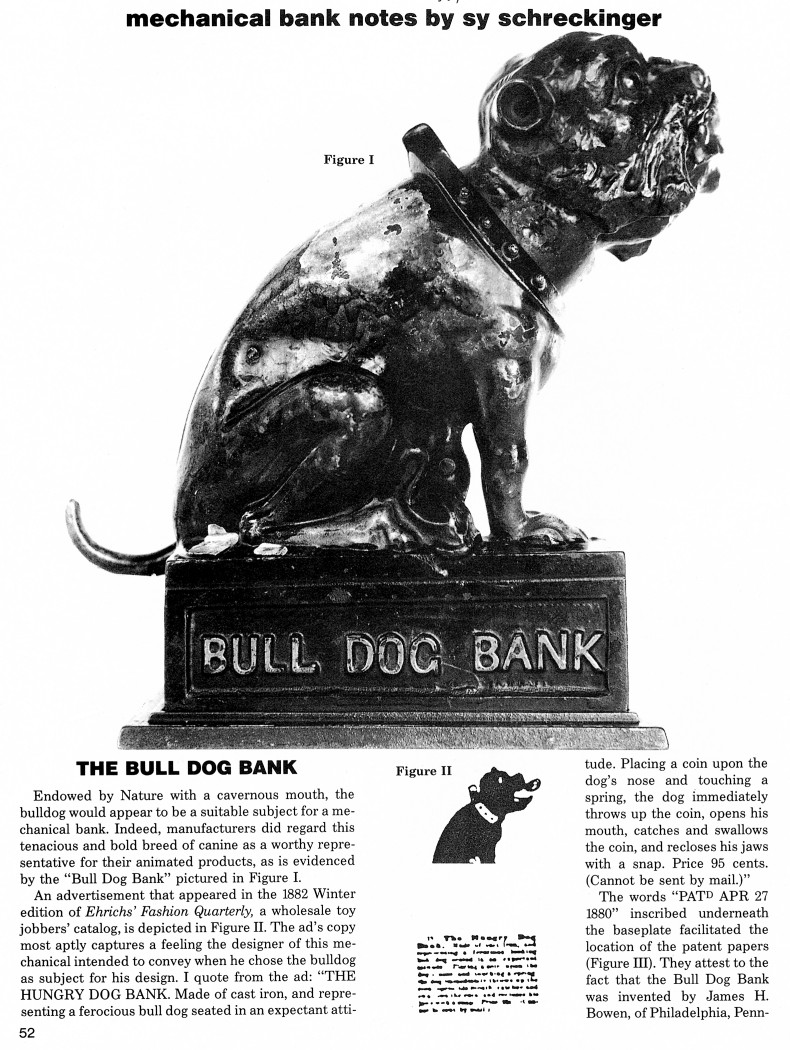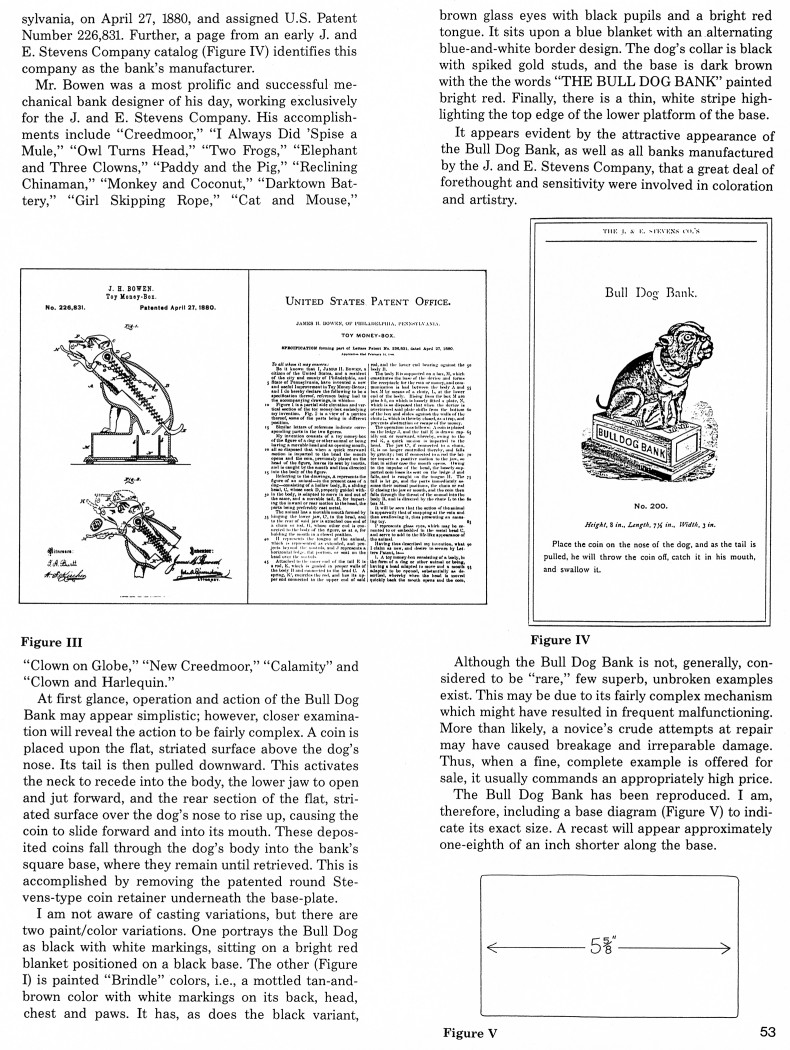|
The Bull Dog Bank
by Sy Schreckinger – ANTIQUE TOY WORLD Magazine – August, 1989
Endowed by Nature
with a cavernous mouth, the bulldog would appear to be a suitable subject
for a mechanical bank. Indeed, manufacturers did regard this tenacious
and bold breed of canine as a worthy representative for their animated
products, as is evidenced by the "Bull Dog Bank" pictured in Figure I.
An advertisement that appeared in the 1882 Winter edition of Ehrichs'
Fashion Quarterly, a wholesale toy jobbers' catalog, is depicted in Figure
II. The ad's copy most aptly captures a feeling the designer of this
mechanical intended to convey when he chose the bulldog as subject for
his design. I quote from the ad: "THE HUNGRY DOG BANK. Made of cast iron,
and representing a ferocious bull dog seated in an expectant attitude.
Placing a coin upon the dog's nose and touching a spring, the dog
immediately throws up the coin, opens his mouth, catches and swallows the
coin, and recloses his jaws with a snap. Price 95 cents. (Cannot be sent
by mail.)"
The words "PATD APR 27 1880" inscribed underneath the baseplate
facilitated the location of the patent papers (Figure III). They attest to
the fact that the Bull Dog Bank was invented by James H. Bowen, of
Philadelphia, Pennsylvania, on April 27, 1880, and assigned U.S. Patent
Number
226,831. Further, a page from an early J. and E. Stevens Company
catalog (Figure IV) identifies this company as the bank's manufacturer.
Mr. Bowen was a most prolific and successful mechanical bank
designer of his day, working exclusively for the J. and E. Stevens
Company. His accomplishments include "Creedmoor," "I Always Did 'Spice a
Mule," "Owl Turns Head," "Two Frogs," "Elephant and Three Clowns," "Paddy
and the Pig," "Reclining Chinaman," "Monkey and Coconut," "Darktown
Battery," "Girl Skipping Rope," "Cat and Mouse, "Clown on Globe," "New
Creedmoor," "Calamity" and "Clown and Harlequin."
At first glance, operation and action of the Bull Dog Bank may appear
simplistic; however, closer examination will reveal the action to be
fairly complex. A coin is placed upon the flat, striated surface above the
dog's nose. Its tail is then pulled downward. This activates the neck to
recede into the body, the lower jaw to open and jut forward, and the rear
section of the flat, striated surface over the dog's nose to rise up,
causing the coin to slide forward and into its mouth. These deposited
coins fall through the dog's body into the bank's square base, where they
remain until retrieved. This is accomplished by removing the patented
round Stevens-type coin retainer underneath the base-plate.
I am not aware of casting variations, but there are two paint/color
variations. One portrays the Bull Dog as black with white markings,
sitting on a bright red blanket positioned on a black base. The other
(Figure I) is painted "Brindle" colors, i.e., a mottled tan-andbrown
color with white markings on its back, head, chest and paws. It has, as
does the black variant, brown glass eyes with black pupils and a bright
red tongue. It sits upon a blue blanket with an alternating blue-and-white
border design. The dog's collar is black with spiked gold studs, and the
base is dark brown with the words "THE BULL DOG BANK" painted bright red.
Finally, there is a thin, white stripe highlighting the top edge of the
lower platform of the base.
It appears evident by the attractive appearance of the Bull Dog
Bank, as well as all banks manufactured by the J. and E. Stevens Company,
that a great deal of forethought and sensitivity were involved in
coloration and artistry.
Although the Bull Dog Bank is not, generally, considered to be
"rare," few superb, unbroken examples exist. This may be due to its fairly
complex mechanism which might have resulted in frequent malfunctioning.
More than likely, a novice's crude attempts at repair may have caused
breakage and irreparable damage. Thus, when a fine, complete example is
offered for sale, it usually commands an appropriately high price.
The Bull Dog Bank has been reproduced. I am, therefore, including a
base diagram (Figure V) to indicate its exact size. A recast will appear
approximately one-eighth of an inch shorter along the base.
|


